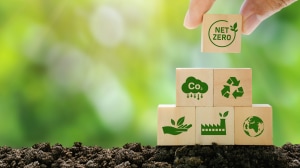May 4, 2023
Your internet browser isn't supported.
Plastic can take up to 1,000 years to decompose,1 putting an incredible strain on natural resources.
Every year, an additional 8 million metric tons of plastic ends up in our oceans2 where it kills over 1 million sea birds and threatens hundreds of marine life species.3
The production of plastic results in the release into the environment of toxic chemicals4 – and it requires more energy consumption than many plastic alternatives.5
When we realized how much plastic we were using in our HALO packaging, we committed to finding more sustainable, Earth- and life-friendly alternatives. Today, all the product packaging for our HALO consumer products is 100% plastic-free and 100% recyclable.
We no longer use clear plastic windows on our product packaging. We’ve replaced them with full-color, high-resolution product photos that allow shoppers to “see” the product inside the box.
Our product boxes no longer need plastic tape to keep them sealed. We redesigned our packaging with tabs that keep our products inside the box.
We eliminated the plastic covers and bags that were once used to keep products and accessories fingerprint- and dust-free. Our cartons are now manufactured using a process that doesn’t produce the dust that used to be an issue. For accessories, we use recyclable bags or we create inserts within the carton to hold the accessories in place.
Our new plastic-free packaging is also smaller in many cases, reducing carbon emissions from transport and materials.
By introducing product multipacks (6-packs, 12-packs, and 24-packs), we create less waste and less garbage for our contractor customers.
As a result of our plastic-free packaging efforts, HALO has been able to eliminate around 100 tons of plastic usage per year. And that has allowed us to help reduce energy consumption, save natural resources, protect wildlife, and reduce pollution.
But we’re not done, yet. As part of our commitment to helping conserve energy and adopt more sustainable practices, we’re continuing to look into other non-plastic alternatives, especially where paper-based materials aren’t practical. We’ll keep you posted on our latest efforts to bring you a brighter, cleaner world.

1wwf.org.au/blogs/the-lifecycle-of-plastics/?rd=1
2theconversation.com/eight-million-tonnes-of-plastic-are-going-into-the-ocean-each-year-37521#:~:text=Around%208%20million%20metric%20tonnes,of%20coastline%20(excluding%20Antarctica)
3opdera.org/more-than-1-million-seabirds-and-100000-marine-animals-die-from-plastic-pollution-every-year/
4env-health.org/turning-the-plastic-tide-the-chemicals-in-plastic-that-put-our-health-at-risk/#:~:text=The%20chemicals%20in%20plastic%20put%20our%20health%20at%20risk&text=Many%20of%20the%20largest%20and,directly%20associated%20with%20plastics%20production
5energy.gov/eere/ammto/articles/us-department-energy-invests-134-million-combat-plastic-waste-reduce-plastic#:~:text=Single%2Duse%20plastics%2C%20such%20as,our%20landfills%20or%20our%20environment

